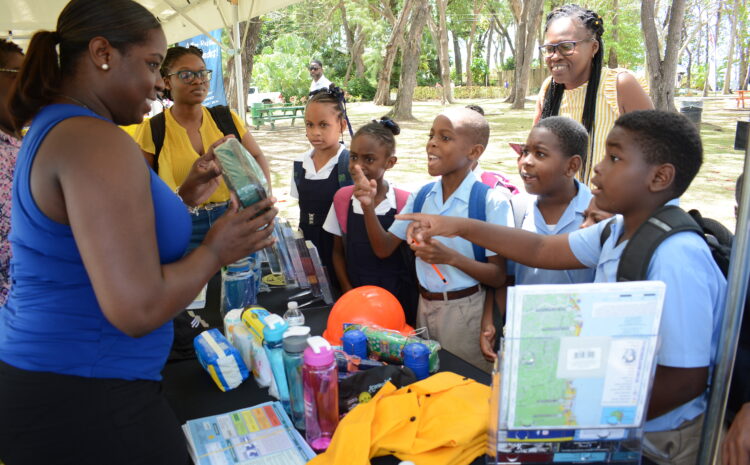Barbados has embarked on a national project to ready its coastal communities to escape approaching tsunamis and significantly reduce the loss of life, the Department of Emergency Management (DEM) has announced.
The plan concentrates on the low-lying west and south coasts where most Barbadians and visitors live and are considered most vulnerable to giant waves triggered by seismic events.
From Six Men’s to Mullins, St Peter in the west, and from Worthing to the Garrison in the south have already completed their Tsunami Ready Recognition processes, said DEM Project Coordinator Selwyn Brooks on Friday.
Speaking at the launch of Coastal Hazards and Earthquake Smart Month at the Folkstone Park and Marine Reserve, St James, Brooks also disclosed that a similar programme for the St James Central area is expected to be completed by the end of this month.
The recognition initiative acknowledges the consequences of a tsunami impact and related threats to life, property and the environment with the primary objective of sharing knowledge with the many residents, businesses, visitors, and hotels along the coastal region.
Brooks, who is also the District Emergency Organisation (DEO) representative for St James Central, explained that the recognition programme would facilitate the timely warning and evacuation process so that the potential loss of life can be significantly reduced and promote timely recovery and rehabilitation.
The disaster manager said a Community Tsunami Emergency Operation Plan in his district, covering from Porters, St James to Batts Rock, St Michael, has now been put in place in collaboration with the DEM, the Coastal Zone Management Unit and other emergency responders.
“The plan covers the emergency preparedness response, and initial recovery arrangements for a tsunami impact, and is linked to the Barbados Tsunami Early Warning Protocol and standard operating procedures as developed by the DEM, thus enabling the involvement of a multi-agency team to effectively execute specific roles and responsibilities,” Brooks said.
“The plan also describes the requirement for alerts and notification of residents, private and business sector, governmental organisations, community-based organisations, and especially the hotel and villa section who accommodate visitors to our island, and the need to be directed accordingly, should our island be impacted.
“Should there be a potential tsunami impact, the Tsunami Warning System for Barbados will be activated by the Pacific Warning Centre to the Barbados Met Services, who will then notify all other relevant authorities. The general public will be notified via public announcement messages on radio and television.”
Brooks highlighted that the DEO, in collaboration with the police and fire services in St James Central, will implement the traffic management plan and mobilise shelters.
He explained that the DEO members would be placed at strategic points to help evacuate residents to higher ground using the designated safe evacuation route. If schools are in session during a tsunami, students and staff would be ushered to pre-established safe assembly points.
“To date, 21 primary evacuation routes have been identified, together with their associated areas that can be used to lead persons to higher ground. A list of vulnerable persons and the potential shelter capacity has been identified if needed.
“It is estimated that over 3 000 residents reside in this area, but this number can fluctuate based on the tourist season,” Brooks said, adding that emergency officials have met with residents and businesses in the community to inform them of their roles and responsibilities should a tsunami strike.
Signs to direct people out of the disaster area are being erected, and billboards with large evacuation maps will soon be put up.
DEM Director Kerry Hinds maintained that building resilience to disaster risk and safeguarding people and communities is central to the DEM’s mandate as the government agency entrusted with leading and coordinating emergency management.
“We have a number of policies including the recently Cabinet-approved National Comprehensive Disaster Management Policy and our current Country Work Programme for Disaster Risk Management,” the emergency management chief noted.
These policies, she said, are aligned with international policies and frameworks including the United Nations 2030 Agenda for Sustainable Development, the Sendai Framework for Disaster Risk Reduction 2015 to 2030 and the United Nations Ocean Decade 2021 to 2030.
In the past 500 years, there have been ten confirmed earthquake-generated tsunamis in the Caribbean Basin with four that killed about 350 people, according to the UWI Seismic Research Centre.
The major tsunami to hit the Caribbean was in 1946, after an 8.1-magnitude earthquake struck the Dominican Republic. Five-metre high waves washed several hundred metres inland across the north-east coast, killing about 1 600 people.
Before 2004, there was virtually no tsunami preparedness or warning systems in the Caribbean until the Indian Ocean disaster that killed about 230 000 people.




